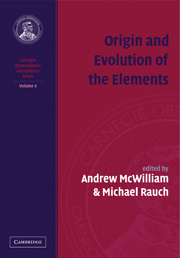Description
Origin and Evolution of the Elements
Carnegie Observatories Astrophysics 4 Volume Paperback Set Series
Coordinators: McWilliam Andrew, Rauch Michael
This Carnegie volume discusses the origin and evolution of elements in our galaxy and others.
Language: English
Subject for Origin and Evolution of the Elements:
Origin and Evolution of the Elements
Publication date: 06-2010
Support: Print on demand
Publication date: 06-2010
Support: Print on demand
Origin & evolution of the elements, (Carnegie observatories astrophysics symposium, Vol. 4)
Publication date: 09-2004
514 p. · 2.9x24.4 cm · Hardback
Publication date: 09-2004
514 p. · 2.9x24.4 cm · Hardback
Description
/li>Contents
/li>
This comprehensive volume reviews our understanding of the origin and evolution of elements, from stellar nucleosynthesis to the chemical evolution of the cosmos. With chapters by leading authorities in the field, it describes models of how the elements are produced by stars, the nuclear processes involved, and how the quantity of elements evolved in our Galaxy and distant galaxies. The observed chemical composition of stars in different locations within our Galaxy and nearby galaxies is discussed, as are the compositions of hot and cold gases, of dust grains found between stars and in meteorites, and of the integrated light from distant galaxies and quasars. This authoritative volume is a valuable resource for graduate students and professional research astronomers.
Introduction; List of participants; 1. Mount Wilson Observatory contributions to the study of cosmic abundances of the chemical elements George W. Preston; 2. Synthesis of the elements in stars: B2FH and beyond E. Margaret Burbidge; 3. Stellar nucleosynthesis: a status report 2003 David Arnett; 4. Advances in r-process nucleosynthesis John J. Cowan and Christopher Sneden; 5. Element yields of intermediate-mass stars Richard B. C. Henry; 6. The impact of rotation on chemical abundances in red giant branch stars Corinne Charbonnel; 7. s-processing in AGB stars and the composition of carbon stars Maurizio Busso, Oscar Straniero, Roberto Gallino, and Carlos Abia; 8. Models of chemical evolution Francesca Matteucci; 9. Model atmospheres and stellar abundance analysis Bengt Gustafsson; 10. The light elements: lithium, beryllium, and boron Ann Merchant Boesgaard; 11. Extremely metal-poor stars John E. Norris; 12. Thin and thick galactic disks Poul E. Nissen; 13. Globular clusters and halo field stars Christopher Sneden, Inese I. Ivans and Jon P. Fulbright; 14. Chemical evolution in ω Centauri Verne V. Smith; 15. Chemical composition of the Magellanic Clouds, from young to old stars Vanessa Hill; 16. Detailed composition of stars in dwarf spheroidal galaxies Matthew D. Shetrone; 17. The evolutionary history of Local Group irregular galaxies Eva K. Grebel; 18. Chemical evolution of the old stellar populations of M31 R. Michael Rich; 19. Stellar winds of hot massive stars nearby and beyond the Local Group Fabio Bresolin and Rolf P. Kudritzki; 20. Presolar stardust grains Donald D. Clayton and Larry R. Nittler; 21. Interstellar dust B. T. Draine; 22. Interstellar atomic abundances Edward B. Jenkins; 23. Molecules in the interstellar medium Tommy Wiklind; 24. Metal ejection by galactic winds Crystal L. Martin; 25. Abundances from the integrated light of globular clusters and galaxies Scott C. Trager; 26. Abundances in spiral and irregular galaxies Donald R. Garnett; 27. Chemical composition of the intracluster medium Michael Loewenstein; 28. Quasar elemental abundances and host galaxy evolution Fred Hamann, Matthias Dietrich, Bassem M. Sabra, and Craig Warner; 29. Chemical abundances in the damped Lyα systems Jason X. Prochaska; 30. Intergalactic medium abundances Robert F. Carswell; 31. Conference summary Bernard E. J. Pagel.
© 2024 LAVOISIER S.A.S.




